『互联网架构』软件架构-Spring boot集成三方中间件(88)
继续说集成三方中间件的,主要说说统异常处理,集成Mybatis,集成redis,集成RabbitMQ。
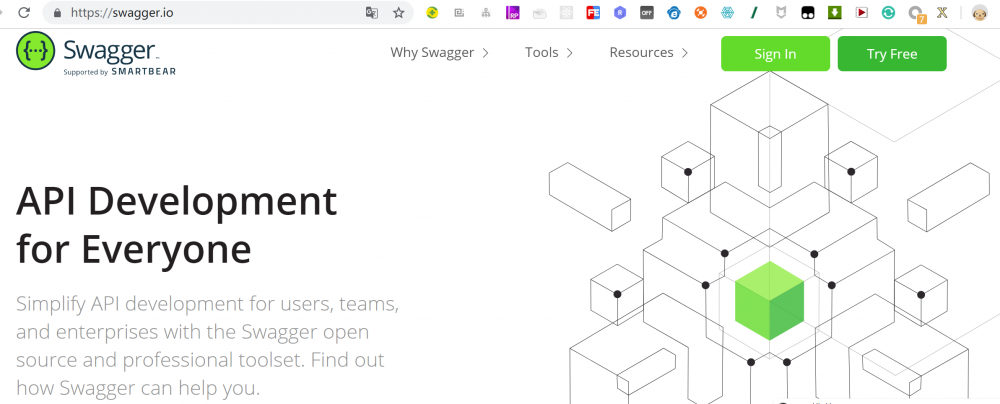
(一)统一异常处理
创建全局异常处理类:通过使用@ControllerAdvice定义统一的异常处理类,@ExceptionHandler用来定义针对的异常类型。
1.创建统一异常Controller
@ControllerAdvice
class GlobalExceptionHandler {
@ExceptionHandler(value = Exception.class)
public ModelAndView defaultErrorHandler(HttpServletRequest req, Exception e)
throws Exception {
ModelAndView mav = new ModelAndView();
mav.addObject("msg", "异常咯...");
mav.setViewName("error");
return mav;
}
}
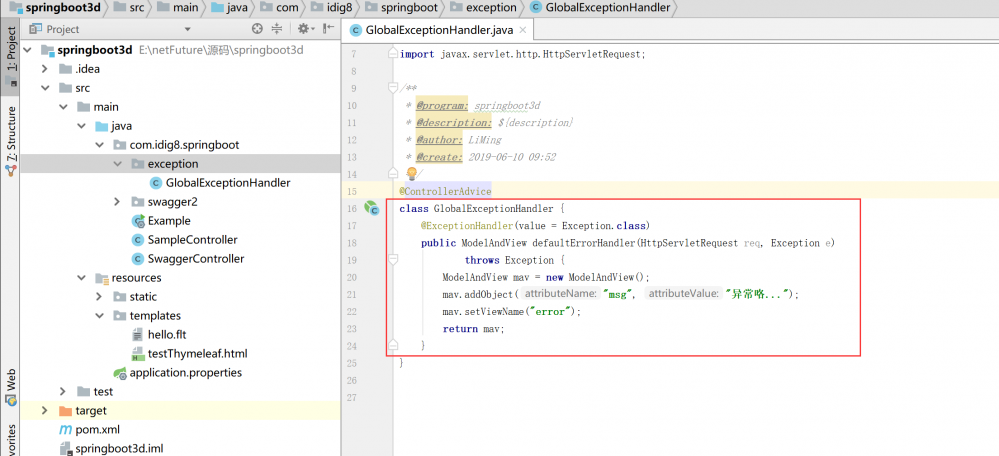
2.增加Controller方法,抛出异常
@RequestMapping("/exception")
public String hello() throws Exception {
throw new Exception("发生错误");
}
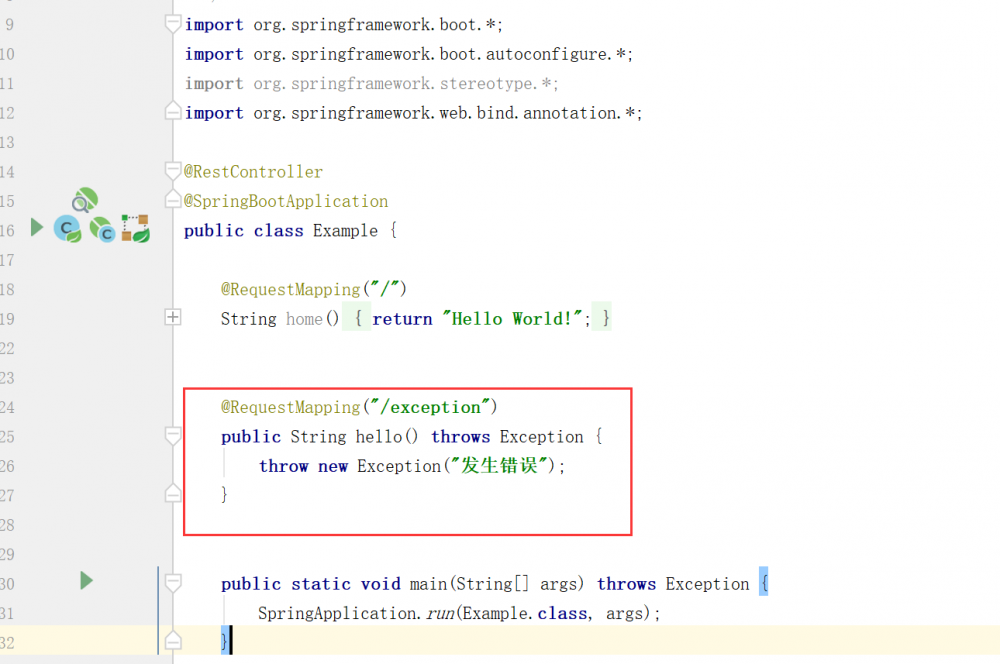
3.src/main/resources/templates增加error.html
<!DOCTYPE html>
<html xmlns:th="http://www.w3.org/1999/xhtml">
<head lang="en">
<meta charset="UTF-8" />
<title>统一异常处理</title>
</head>
<body>
<h1>Error</h1>
<div th:text="${msg}"></div>
</body>
</html>
````

#### (二)集成Mybatis
>1.修改pom.xml,增加依赖
``` xml
<dependency>
<groupId>org.mybatis.spring.boot</groupId>
<artifactId>mybatis-spring-boot-starter</artifactId>
<version>1.1.1</version><!-- 版本号必须需要 -->
</dependency>
<dependency>
<groupId>mysql</groupId>
<artifactId>mysql-connector-java</artifactId>
</dependency>
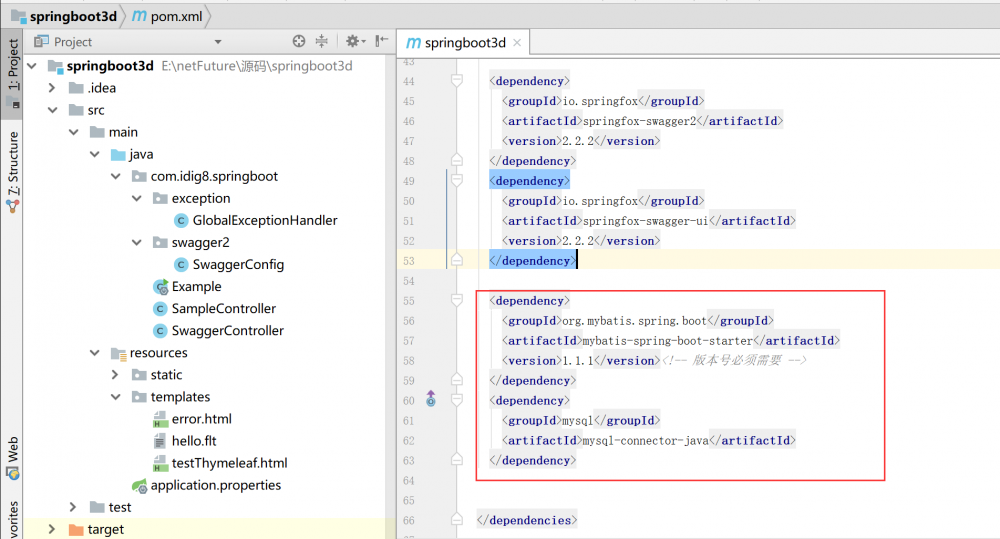
2.mysql的连接配置
application.properties:
spring.datasource.url=jdbc:mysql://localhost:3306/spring spring.datasource.username=root spring.datasource.password=root spring.datasource.driver-class-name=com.mysql.jdbc.Driver
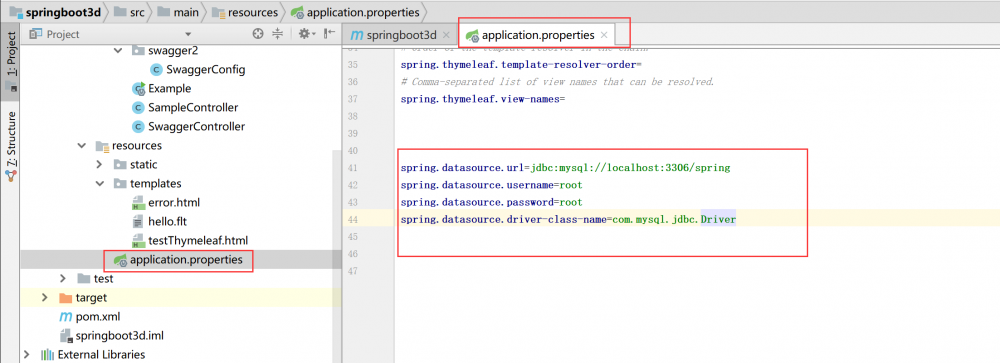
3.创建表t_user
CREATE TABLE `t_user` ( `id` int(11) NOT NULL AUTO_INCREMENT, `name` varchar(40) DEFAULT NULL, `age` int(11) DEFAULT NULL, `address` varchar(100) DEFAULT NULL, `phone` varchar(40) DEFAULT NULL, PRIMARY KEY (`id`) ) ENGINE=InnoDB AUTO_INCREMENT=1 DEFAULT CHARSET=utf8;
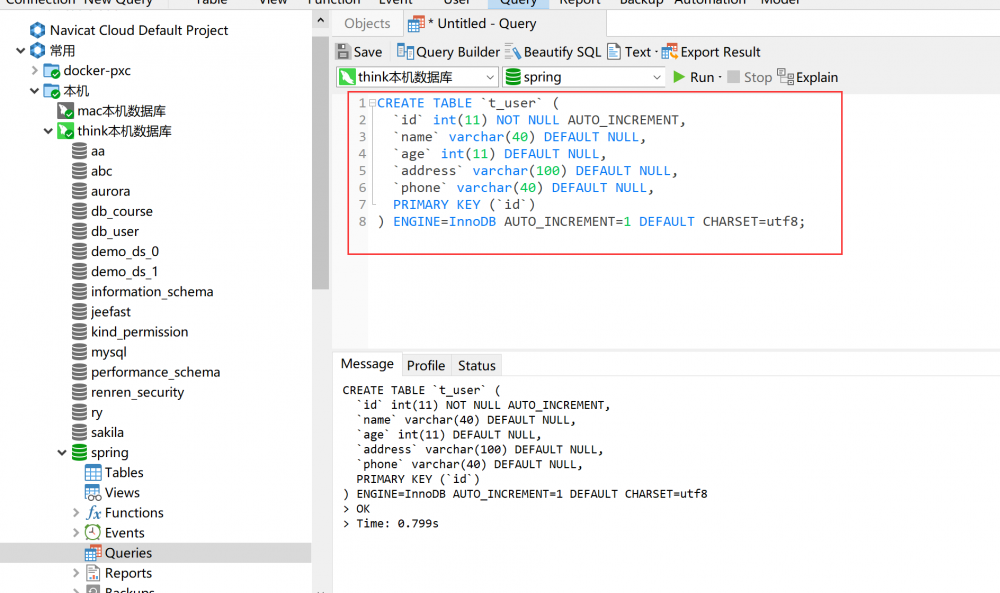
4.创建User.java文件
包名为:com.idig8.springboot.bean
package com.idig8.springboot.bean;
/**
* @program: springboot3d
* @description: ${description}
* @author: LiMing
* @create: 2019-06-10 11:07
**/
public class User {
private Integer id;
private String name;
private Integer age;
private String address;
private String phone;
public Integer getId() {
return id;
}
public void setId(Integer id) {
this.id = id;
}
public String getName() {
return name;
}
public void setName(String name) {
this.name = name;
}
public Integer getAge() {
return age;
}
public void setAge(Integer age) {
this.age = age;
}
public String getAddress() {
return address;
}
public void setAddress(String address) {
this.address = address;
}
public String getPhone() {
return phone;
}
public void setPhone(String phone) {
this.phone = phone;
}
}

5.创建UserMapper.java接口文件
包名为:com.idig8.springboot.mybatis
package com.idig8.springboot.mybatis;
import com.idig8.springboot.bean.User;
import org.apache.ibatis.annotations.Insert;
import org.apache.ibatis.annotations.Mapper;
import org.apache.ibatis.annotations.Param;
import org.apache.ibatis.annotations.Select;
/**
* @program: springboot3d
* @description: ${description}
* @author: LiMing
* @create: 2019-06-10 11:09
**/
@Mapper
public interface UserMapper {
/**根据id查询用户*/
@Select("SELECT * FROM T_USER WHERE ID = #{id}")
User findById(@Param("id") String id);
/**新增用户*/
@Insert("INSERT INTO T_USER(NAME, AGE, ADDRESS, PHONE) VALUES(#{name}, #{age}, #{address}, #{phone})")
int insert(@Param("name") String name, @Param("age") Integer age,@Param("address") String address,@Param("phone") String phone);
}
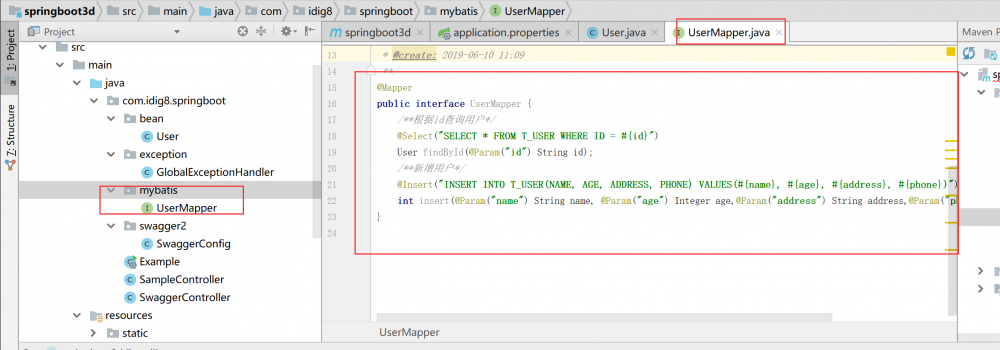
6.测试
@RunWith(SpringJUnit4ClassRunner.class)
@SpringBootTest(classes = Example.class)
public class MybatisTest {
@Autowired
private UserMapper userMapper;
@Test
public void testInsert() throws Exception {
int num = userMapper.insert("zhangsan222", 20,"长沙","13100000000");
TestCase.assertEquals(num,1);
}
@Test
public void testFindById() throws Exception {
User u = userMapper.findById("6");
TestCase.assertNotNull(u);
System.out.println(u.getName());
}
(三)集成Mybatis
1.修改pom.xml,增加依赖
<dependency> <groupId>org.springframework.boot</groupId> <artifactId>spring-boot-starter-data-redis</artifactId> </dependency>
注意:旧版本spring boot中集成的redis starter为:spring-boot-starter-redis
2.redis连接配置
注意:spring.redis.database的配置通常使用0即可,Redis在配置的时候可以设置数据库数量,默认为16,可以理解为数据库的schema。
# REDIS (RedisProperties) # Redis数据库索引(默认为0) spring.redis.database=0 # Redis服务器地址 spring.redis.host=127.0.0.1 # Redis服务器连接端口 spring.redis.port=6379 # Redis服务器连接密码(默认为空) spring.redis.password= # 连接池最大连接数(使用负值表示没有限制) spring.redis.pool.max-active=8 # 连接池最大阻塞等待时间(使用负值表示没有限制) spring.redis.pool.max-wait=-1 # 连接池中的最大空闲连接 spring.redis.pool.max-idle=8 # 连接池中的最小空闲连接 spring.redis.pool.min-idle=0 # 连接超时时间(毫秒) spring.redis.timeout=0
3.测试redis
注意:redis中存储对象,需要我们自己实现RedisSerializer
@RunWith(SpringJUnit4ClassRunner.class)
@SpringBootTest(classes = SpringBootMain.class)
public class SpringRedisTest {
@Autowired
private RedisTemplate<String,String> redisTemplate;
@Test
public void testRedis() throws Exception {
ValueOperations<String, String> ops = redisTemplate.opsForValue();
ops.set("name", "zhangsan");
String value = ops.get("name");
System.out.println(value);
TestCase.assertEquals("zhangsan", value);
}
}
(四)集成RabbitMQ
RabbitMQ是以AMQP协议实现的一种消息中间件产品, AMQP是Advanced Message Queuing Protocol的简称,它是一个面向消息中间件的开放式标准应用层协议。 AMQP中定义了以下标准特性: 1.消息方向 2.消息队列 3.消息路由(包括:点到点模式和发布-订阅模式) 4.可靠性 5.安全性 关于AMQP 、RabbitMQ的详细内容不再这里过多介绍,本次课主要讲怎么与Spring boot集成。
-
安装RabbitMQ
> 官网:https://www.rabbitmq.com/download.html
> windows安装不在说了,都是傻瓜试的。linux可能比较麻烦自行百度吧。
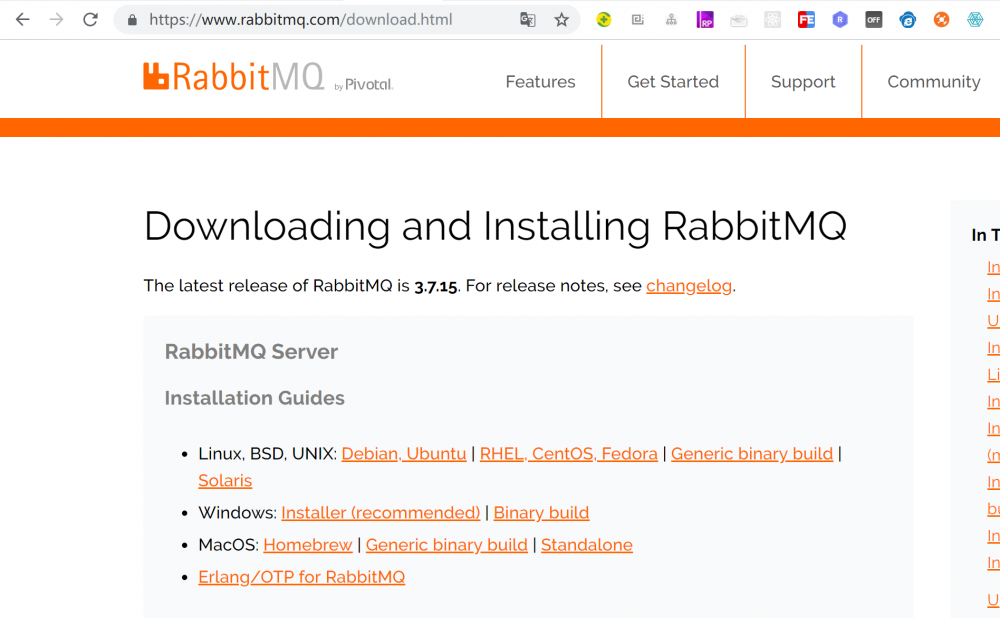
打开浏览器并访问: http://localhost:15672/ ,并使用默认用户guest登录,密码也为guest,即可进入管理界面
新增管理用户并设置权限
username:springboot
password:123456

切换到springboot用户登陆,在All users中,点击Name为springboot, 进入权限设置页面

在权限设置页面,进入Permissions页面,点击“Set permission”
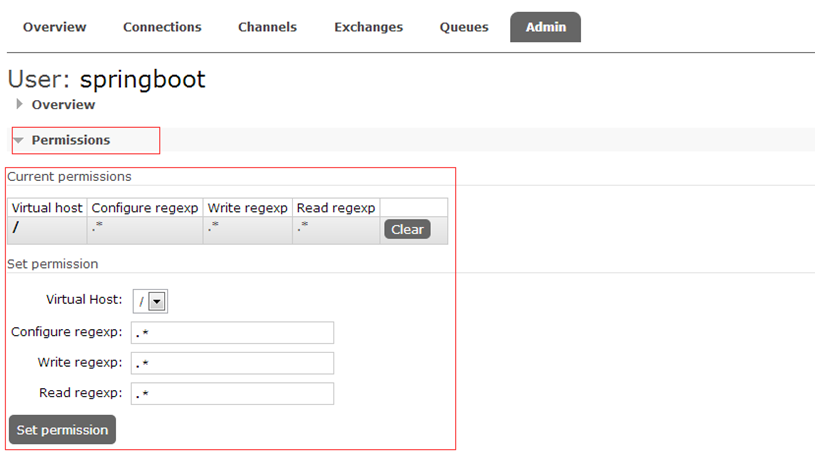
- Spring Boot整合修改pom.xml,增加依赖支持
<dependency>
<groupId>org.springframework.boot</groupId>
<artifactId>spring-boot-starter-amqp</artifactId>
</dependency>
- rabbit mq连接配置
spring.rabbitmq.host=localhost spring.rabbitmq.port=5672 spring.rabbitmq.username=springboot spring.rabbitmq.password=123456
-
创建Rabbit配置类
>配置类主要用来配置队列、交换器、路由等高级信息
import org.springframework.amqp.core.Queue;
import org.springframework.context.annotation.Bean;
import org.springframework.context.annotation.Configuration;
@Configuration
public class RabbitConfig {
@Bean
public Queue firstQueue() {
// 创建一个队列,名称为:first
return new Queue("first");
}
}
-
创建消息产生者类
> 说明:通过注入AmqpTemplate接口的实例来实现消息的发送,AmqpTemplate接口定义了一套针对AMQP协议的基础操作。
@Component
public class Sender {
@Autowired
private AmqpTemplate rabbitTemplate;
public void send() {
rabbitTemplate.convertAndSend("first", "test rabbitmq message !!!");
}
}
-
创建消息消费者
>说明:
@RabbitListener注解:定义该类需要监听的队列
@RabbitHandler注解:指定对消息的处理
@Component
@RabbitListener(queues = "first")
public class Receiver {
@RabbitHandler
public void process(String msg) {
System.out.println("receive msg : " + msg);
}
}
- 创建测试类
@RunWith(SpringJUnit4ClassRunner.class)
@SpringBootTest(classes = SpringBootMain.class)
public class RabbitmqTest {
@Autowired
private Sender sender;
@Test
public void testRabbitmq() throws Exception {
sender.send();
}
}
- 启动主程序:SpringBootMain
控制台如果出现以下信息,则说明rabbitmq连接成功
Created new connection: rabbitConnectionFactory#29102d45:0/SimpleConnection@1dcfb5ba [delegate=amqp://springboot@127.0.0.1:5672/, localPort= 55088]
- 运行Junit测试类
控制台输出: receive msg : test rabbitmq message !!! 集成Rabbit MQ完毕!
PS:mq和redis之前在别的专题都说过多次了,这里就不详细的截图了。下次咱们一起说说 日志方面。
百度未收录
>>原创文章,欢迎转载。转载请注明:转载自IT人故事会,谢谢!
>>原文链接地址:上一篇:已是最新文章
- 本文标签: tar sql IT人 XML dataSource Word IO 索引 spring windows https 安全 管理 消息队列 点到点 http mapper amqp rmi tab ip cat redis 实例 百度 core bean rabbitmq 2019 mysql 测试 servlet 产品 数据 Select mybatis src connectionFactory springboot tag linux 协议 互联网 UI HTML 软件 dist queue Spring Boot junit 服务器 数据库 配置 App list example message id JDBC root pom description 安装 CTO value schema 文章 MQ 连接池 apache db find map 时间 key Connection ACE iBATIS equals java 端口
- 版权声明: 本文为互联网转载文章,出处已在文章中说明(部分除外)。如果侵权,请联系本站长删除,谢谢。
- 本文海报: 生成海报一 生成海报二











![[HBLOG]公众号](https://www.liuhaihua.cn/img/qrcode_gzh.jpg)

